形容词和副词的比较级和最高级(完美版)
- 格式:doc
- 大小:62.50 KB
- 文档页数:3
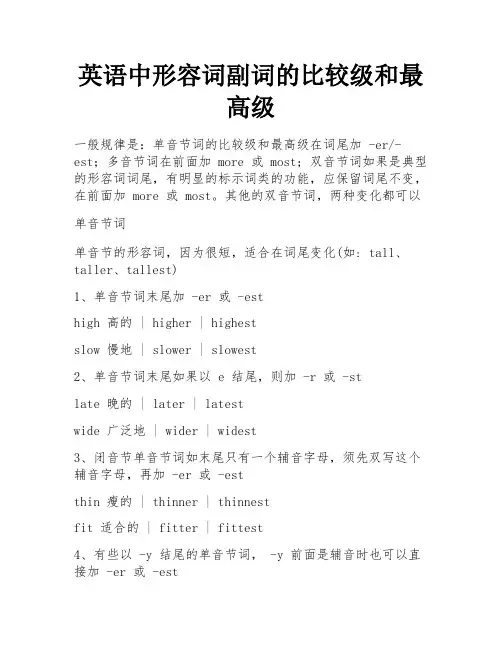
英语中形容词副词的比较级和最高级一般规律是:单音节词的比较级和最高级在词尾加 -er/-est;多音节词在前面加 more 或 most;双音节词如果是典型的形容词词尾,有明显的标示词类的功能,应保留词尾不变,在前面加 more 或 most。
其他的双音节词,两种变化都可以单音节词单音节的形容词,因为很短,适合在词尾变化(如: tall、taller、tallest)1、单音节词末尾加 -er 或 -esthigh 高的 | higher | highestslow 慢地 | slower | slowest2、单音节词末尾如果以 e 结尾,则加 -r 或 -stlate 晚的 | later | latestwide 广泛地 | wider | widest3、闭音节单音节词如末尾只有一个辅音字母,须先双写这个辅音字母,再加 -er 或 -estthin 瘦的 | thinner | thinnestfit 适合的 | fitter | fittest4、有些以 -y 结尾的单音节词, -y 前面是辅音时也可以直接加 -er 或 -estshy 害羞的 | shyer | shyestsly 狡猾的 | slyer | slyestwry 讽刺的 | wryer | wryest多音节词三个音节以上的多音节词已经很长,不适合再加词尾变化,因而在前面加 more 或 most,表示更(最)...,或者加 less 或least ,表示更(最)不...interesting 有趣的 | more interesting | most interestingimportant 重要的 | less important | least importantcarefully 认真地 | more carefully | most carefully双音节词双音节形容词很尴尬:不长不短,怎么判断?1、词尾是典型的形容词词尾,有明显的标示词类的功能,应保留词尾不变,在前面加 more 或 mostcrowded more crowded most crowdedloving more loving most lovinghelpful more helpful most helpfulfamous more famous most famousactive more active most active2、其他的双音节形容词,如果不是典型的形容词字尾,变化则无限制,两种变化都可以often oftener(more often) oftenest(most often)shallow shallower(more shallow) shallowest(most shallow)3、如果是 -y 结尾,这个长母音因为发音上的要求,要先变成短母音的 i,再加字尾变化,如:happy happier happiestlucky luckier luckiest二、不规则形式good/well | better | bestbad/ill/badly | worse | worstmany/much | more | mostlittle | less | leastfar | farther/further | farthest/furthestold | older/elder | oldest/eldest三、比较等级英语中形容词副词有三个比较等级,即原级、比较级和最高级1、原级(1) 表示程度相同,即“和...一样...”时用原级,常用"as... as" 结构It is as beautiful as paradise in Heaven. 这里如天堂般美丽This room is as broad as it is long. 那个房间长宽相等He is as handsome as John (is). 他和约翰一样英俊He studies as hard as John (does). 他和约翰一样努力(2) as...as... 引导的结构可采用倒装句型He studies as hard as John (does). = He studies as hard as does John.He is as handsome as John is. = He is as handsome as is John.(3) 否定的原级用 not as...as 或not so...as,二者区别不大You are not as tall as he. 你没有他高Guangzhou is not as clean as Shanghai. 广州没有上海那么干净I didn't do so well as I should. 我做得不如我应做得那么好(4) as/so... as... 结构前可以用 just、quite、almost、nearly、half 等词在程度上加以修饰This story was quite as interesting as we had thought. 这个故事和我们想的一样精彩The bike is not half so new as mine. 这辆自行车还没我的一半新She can read twice as fast as he does. 她的阅读速度比他快一倍John is not quite as good a student as his sister.连接词 as 表示这是组 as..as 的比较级。
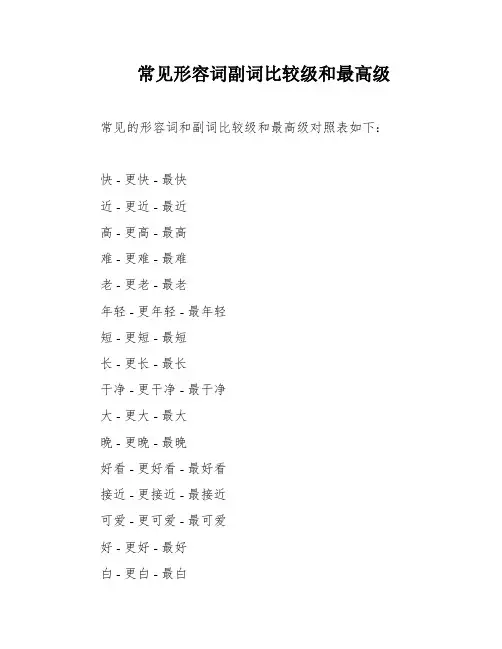
常见形容词副词比较级和最高级
常见的形容词和副词比较级和最高级对照表如下:
快 - 更快 - 最快
近 - 更近 - 最近
高 - 更高 - 最高
难 - 更难 - 最难
老 - 更老 - 最老
年轻 - 更年轻 - 最年轻
短 - 更短 - 最短
长 - 更长 - 最长
干净 - 更干净 - 最干净
大 - 更大 - 最大
晚 - 更晚 - 最晚
好看 - 更好看 - 最好看
接近 - 更接近 - 最接近
可爱 - 更可爱 - 最可爱
好 - 更好 - 最好
白 - 更白 - 最白
大 - 更大 - 最大
热 - 更热 - 最热
瘦 - 更瘦 - 最瘦
忙 - 更忙 - 最忙
早 - 更早 - 最早
容易 - 更容易 - 最容易快乐 - 更快乐 - 最快乐丑 - 更丑 - 最丑
友善 - 更友善 - 最友善美丽 - 更美丽 - 最美丽美味 - 更美味 - 最美味有趣 - 更有趣 - 最有趣耐心 - 更耐心 - 最耐心无聊 - 更无聊 - 最无聊缓慢 - 更缓慢 - 最缓慢可怕 - 更可怕 - 最可怕兴奋 - 更兴奋 - 最兴奋重要 - 更重要 - 最重要危险 - 更危险 - 最危险好 - 更好 - 最好
多 - 更多 - 最多。
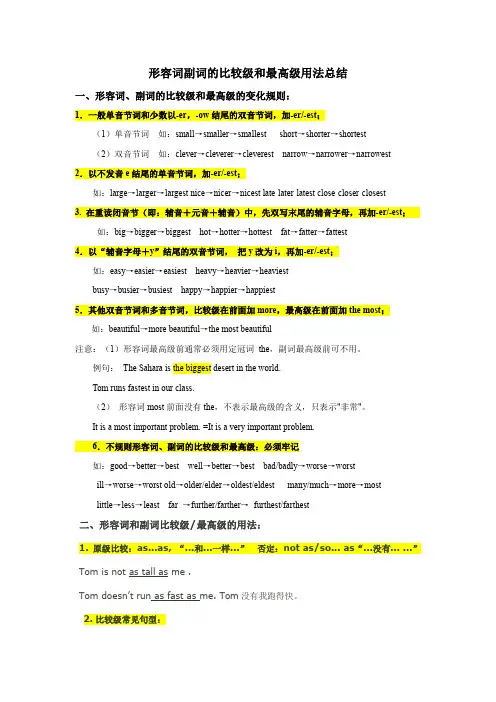
形容词副词的比较级和最高级用法总结一、形容词、副词的比较级和最高级的变化规则:1.一般单音节词和少数以-er,-ow结尾的双音节词,加-er/-est;(1)单音节词如:small→smaller→smallest short→shorter→shortest(2)双音节词如:clever→cleverer→cleverest narrow→narrower→narrowest2.以不发音e结尾的单音节词,加-er/-est;如:large→larger→largest nice→nicer→nicest late-later-latest close-closer-closest3. 在重读闭音节(即:辅音+元音+辅音)中,先双写末尾的辅音字母,再加-er/-est;如:big→bigger→biggest hot→hotter→hottest fat→fatter→fattest4.以“辅音字母+y”结尾的双音节词,把y改为i,再加-er/-est;如:easy→easier→easiest heavy→heavier→heaviestbusy→busier→busiest happy→happier→happiest5.其他双音节词和多音节词,比较级在前面加more,最高级在前面加the most;如:beautiful→more beautiful→the most beautiful注意:(1)形容词最高级前通常必须用定冠词the,副词最高级前可不用。
例句:The Sahara is the biggest desert in the world.Tom runs fastest in our class.(2)形容词most前面没有the,不表示最高级的含义,只表示"非常"。
It is a most important problem. =It is a very important problem.6.不规则形容词、副词的比较级和最高级:必须牢记如:good→better→best well→better→best bad/badly→worse→worstill→worse→worst old→older/elder→oldest/eldest many/much→more→mostlittle→less→least far →further/farther→furthest/farthest二、形容词和副词比较级/最高级的用法:1. 原级比较:as...as, “...和...一样...”否定:not as/so... as“...没有... ...”Tom is not as tall as me .Tom doesn’t run as fast as me. Tom没有我跑得快。
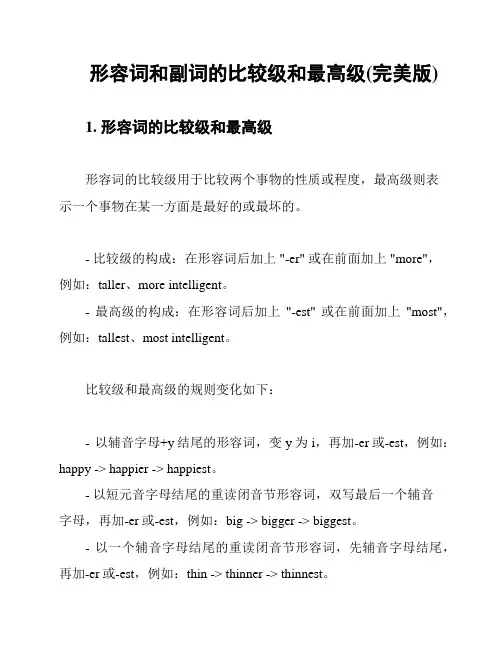
形容词和副词的比较级和最高级(完美版)1. 形容词的比较级和最高级形容词的比较级用于比较两个事物的性质或程度,最高级则表示一个事物在某一方面是最好的或最坏的。
- 比较级的构成:在形容词后加上 "-er" 或在前面加上 "more",例如:taller、more intelligent。
- 最高级的构成:在形容词后加上"-est" 或在前面加上"most",例如:tallest、most intelligent。
比较级和最高级的规则变化如下:- 以辅音字母+y结尾的形容词,变y为i,再加-er或-est,例如:happy -> happier -> happiest。
- 以短元音字母结尾的重读闭音节形容词,双写最后一个辅音字母,再加-er或-est,例如:big -> bigger -> biggest。
- 以一个辅音字母结尾的重读闭音节形容词,先辅音字母结尾,再加-er或-est,例如:thin -> thinner -> thinnest。
- 多音节和部分双音节形容词前加more或most,例如:beautiful -> more beautiful -> most beautiful。
2. 副词的比较级和最高级副词的比较级和最高级的构成方式与形容词类似,只是在形容词的基础上加上 "-ly" 构成副词。
- 比较级的构成:在副词后加上 "-er" 或在前面加上 "more",例如:faster、more quickly。
- 最高级的构成:在副词后加上 "-est" 或在前面加上 "most",例如:fastest、most quickly。
与形容词类似,副词的规则变化也遵循相同的规律。
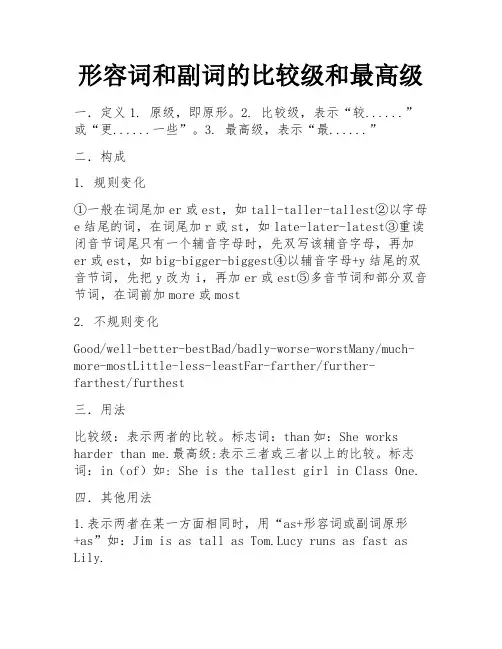
形容词和副词的比较级和最高级一.定义1. 原级,即原形。
2. 比较级,表示“较......”或“更......一些”。
3. 最高级,表示“最......”二.构成1. 规则变化①一般在词尾加er或est,如tall-taller-tallest②以字母e结尾的词,在词尾加r或st,如late-later-latest③重读闭音节词尾只有一个辅音字母时,先双写该辅音字母,再加er或est,如big-bigger-biggest④以辅音字母+y结尾的双音节词,先把y改为i,再加er或est⑤多音节词和部分双音节词,在词前加more或most2. 不规则变化Good/well-better-bestBad/badly-worse-worstMany/much-more-mostLittle-less-leastFar-farther/further-farthest/furthest三.用法比较级:表示两者的比较。
标志词:than如:She works harder than me.最高级:表示三者或三者以上的比较。
标志词:in(of)如: She is the tallest girl in Class One.四.其他用法1.表示两者在某一方面相同时,用“as+形容词或副词原形+as”如:Jim is as tall as Tom.Lucy runs as fast as Lily.2.表示一方在某方面不如另一方时,用“not as/so+形容词或副词原形+as”如:Jim is not as/so smart as Tom.3.比较级+and+比较级,more and more+原级,译为越来越......如:The weather is getting colder andcolder.She bees more and more beautiful.4.the+比较级,the+比较级。
意思是越......越......如:The harder you are,the luckier you are.5.比较级常见修饰词如:much,a lot, far,a little,evenShe is much taller than me.---完---也许你还想看:“如此”这样用动词短语的用法。

四、形容词和副词的比较级、最高级(Comparison of Adjectives and Adverbs)I. 形容词比较级和最高级的形式一、形容词比较级和最高级的构成⑥合成形容词的比较等级•大多数在前面加more及most。
例如:home-sick, more home-sick, most home-sickup-to-date, more up-to-date, most up-to-date•若第一个词是大家熟悉的单音节词,则-er及-est都加在这个词的前面。
例:Long-lasting, longer-lasting, longest-lastinghard-working, harder-working, hardest-workingKind-hearted, kinder-hearted, kindest-heartedWell-known, better-known, best-known二、不规则形容词的比较级和最高级形式II.副词比较级和最高级的形式副词比较级和最高级的变化形式与形容词基本上一样。
一、一般副词hard→harder →hardest fast→faster →fastestlate→later →latest early→earlier →earliest二、特殊副词well →better →best much →more →mostbadly →worse →worst little →less →least三、开放类副词开放类副词即以后缀-ly结尾的副词不能像形容词那样加-er或-est,而应在副词原形前加more或most。
如:quickly →more quickly →most quickly quietly →more quietly →most qui etlyIII.形容词与副词比较级和最高级的基本用法一、比较级1.比较级通常由“形容词(副词)比较级+than+…”构成,表示在两者中间一方比另一方“更加……”。
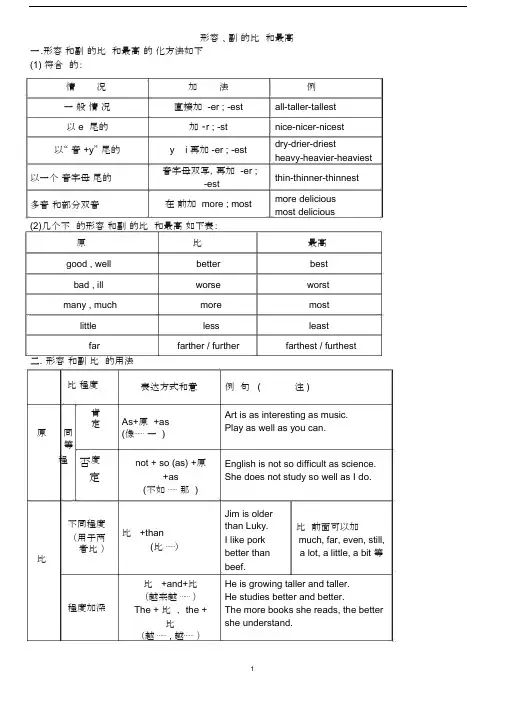
形容、副的比和最高一.形容和副的比和最高的化方法如下(1) 符合的:情况加法例一般情况直接加 -er ; -est all-taller-tallest以 e 尾的加–r ; -st nice-nicer-nicest以“ 音 +y” 尾的y i 再加 -er ; -est dry-drier-driestheavy-heavier-heaviest以一个音字母尾的音字母双写,再加 -er ;thin-thinner-thinnest -est多音和部分双音在前加 more ; most more delicious most delicious(2)几个不的形容和副的比和最高如下表:原比最高good , well better bestbad , ill worse worst many , much more most little less leastfar farther / further farthest / furthest 二.形容和副比的用法比程度肯定原同等程否度定不同程度(用于两者比)比程度加深表达方式和意例句 (注 )As+原 +asArt is as interesting as music.Play as well as you can.(像⋯⋯一 )not + so (as) +原English is not so difficult as science.+as She does not study so well as I do.(不如⋯⋯那 )Jim is older比 +thanthan Luky.比前面可以加I like pork much, far, even, still,(比⋯⋯)better than a lot, a little, a bit 等beef.比 +and+比He is growing taller and taller.(越来越⋯⋯ )He studies better and better.The + 比, the +The more books she reads, the better 比she understand.(越⋯⋯ , 越⋯⋯)最高程度副最Spring is the best season of 高前最高(用于三The +最高 +of (in)the year.面的者或三者(最⋯⋯)Lin Tao jumped (the)the 往往以上)farthest of all.省略三.形容副比最高的其他用法( 1)和冠用the +形容原+ v(复),指一人或物the +形容比,指两者中“ ⋯的”的那一个, eg. the younger of the a/ an +形容比 eg. The pen is expensive. I want a cheaper one.( a) +most+形容最高“非常⋯” eg. a most beautiful city ( 2 ) 相关构a. 原比:肯定句as⋯ .as ⋯ .,否定句 not so / as⋯ .as ⋯..b.比句:比+than⋯或. more (less)⋯.than⋯ ..The furniture in this shop is less beautiful than that in that shop.c.比+ and+比或 more and more+比“越来越⋯ ” richer andricher, more and more interesting d. The more ⋯ .., the more 越⋯⋯..,“ 越⋯”The more you look at the picture, the better you will like it.e. 比+ than any other +n. ()(适用于范一致)(all) other + n.(复)any +n.( )(适用于范不一致)He is taller than any other student / all other students in his class.any student in my class.f. 倍数表达法。
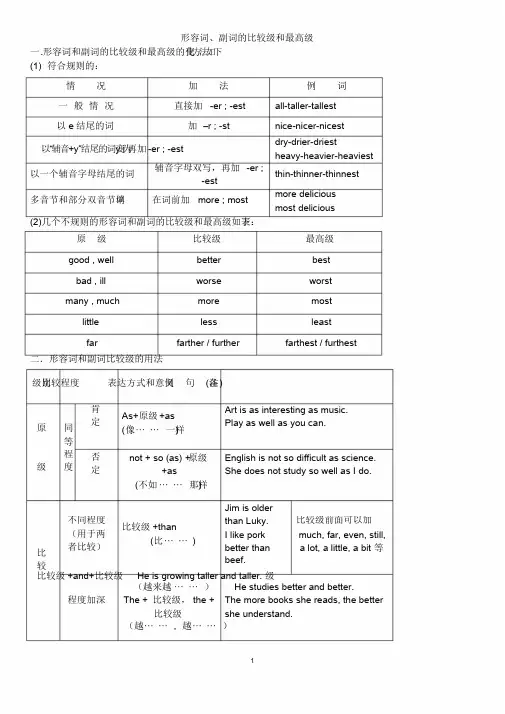
形容词、副词的比较级和最高级一.形容词和副词的比较级和最高级的变化方法如下(1) 符合规则的:情况加法例词一般情况直接加-er ; -est all-taller-tallest以e 结尾的词加–r ; -st nice-nicer-nicest以“辅音+y”结尾的词变y为i再加-er ; -est dry-drier-driestheavy-heavier-heaviest以一个辅音字母结尾的词辅音字母双写,再加-er ;-estthin-thinner-thinnest多音节和部分双音节单词在词前加more ; most more delicious most delicious(2)几个不规则的形容词和副词的比较级和最高级如下表:原级比较级最高级good , well better bestbad , ill worse worst many , much more most little less leastfar farther / further farthest / furthest 二.形容词和副词比较级的用法级别比较程度表达方式和意义例句(备注)原同肯定As+原级+as(像⋯⋯一样)Art is as interesting as music.Play as well as you can.等级程度否定not + so (as) +原级+asE nglish is not so difficult as science.She does not study so well as I do.(不如⋯⋯那样)Jim is older比较不同程度(用于两者比较)比较级+than(比⋯⋯)t han Luky.I like porkbetter thanbeef.比较级前面可以加much, far, even, still,a lot, a little, a bit 等比较级+and+比较级He is growing taller and taller. 级(越来越⋯⋯)He studies better and better.程度加深The + 比较级,the + The more books she reads, the better比较级she understand.(越⋯⋯, 越⋯⋯)1最高级最高程度(用于三者或三者以上)The +最高级+of (in)(最⋯⋯)Spring is the best season ofthe year.Lin Tao jumped (the)farthest of all.副词最高级前面的the 往往省略三.形容词副词比较级最高级的其他用法( 1)和冠词连用the +形容词原级+v(复),指一类人或物the +形容词比较级,指两者中“较⋯的”的那一个,eg. the younger of thea/ an +形容词比较级eg. The pen is expensive. I want a cheaper one.( a) +most+形容词最高级“非常⋯”eg. a most beautiful city( 2 ) 相关结构a. 原级比较:肯定句as⋯.as ⋯.,否定句not so / as⋯.as ⋯..b.比较句:比较级+than ⋯或.more (less) ⋯.than ⋯..The furniture in this shop is less beautiful than that in that shop.c.比较级+and+比较级或more and more+比较级“越来越⋯”richer and richer, more and more interestingd. The more ⋯.., the more 越⋯⋯.. ,“越⋯”The more you look at the picture, the better you will like it.e. 比较级+than any other +n. (单)(适用于范围一致时)(all) other +n.(复)any +n.(单) (适用于范围不一致时)He is taller than any other student / all other students in his class.any student in my class.f. 倍数表达法。
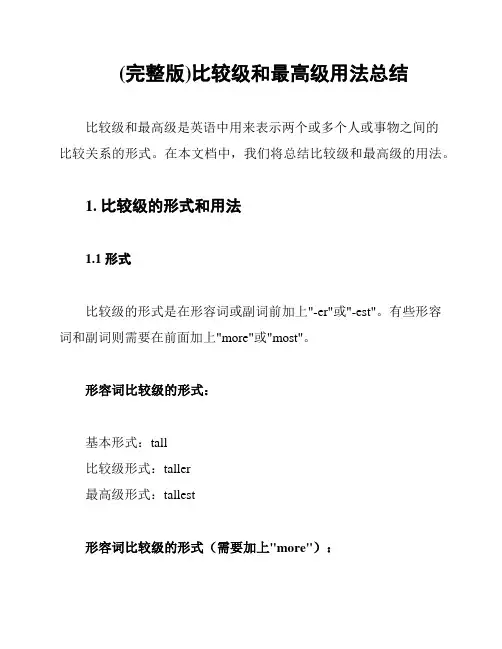
(完整版)比较级和最高级用法总结比较级和最高级是英语中用来表示两个或多个人或事物之间的比较关系的形式。
在本文档中,我们将总结比较级和最高级的用法。
1. 比较级的形式和用法1.1 形式比较级的形式是在形容词或副词前加上"-er"或"-est"。
有些形容词和副词则需要在前面加上"more"或"most"。
形容词比较级的形式:基本形式:tall比较级形式:taller最高级形式:tallest形容词比较级的形式(需要加上"more"):基本形式:beautiful比较级形式:more beautiful最高级形式:most beautiful副词比较级的形式:基本形式:quickly比较级形式:more quickly 或 faster最高级形式:most quickly 或 fastest1.2 用法比较级常用于以下几种情况:- 比较两个人或物体的相对性质或程度。
例如:- He is taller than his brother.- This book is more interesting than that one.- 比较两个人或物体进行选择或决策。
例如:- I prefer coffee to tea.- She is more suitable for the job.- 表示一个人或物体在某一方面比另一个人或物体更具特征。
例如:- The second movie was scarier than the first one.- He is more intelligent than his classmates.2. 最高级的形式和用法2.1 形式最高级的形式是在形容词或副词前加上定冠词"the",并在其后加上"-est"。
有些形容词和副词则需要在前面加上"most"。

形容词和副词的比较级和最高级(完美版)一、形容词和副词的比较级和最高级的变化方法如下:1) 符合规则的情况:一般情况:直接加-er;-est以e结尾的词:加-r;-st以“辅音+y”结尾的词:变y为i再加-er;-est以一个辅音字母结尾的词:辅音字母双写,再加-er;-est例词:all-taller-tallest,nice-nicer-nicest,dry-drier-driest,heavy-heavier-heaviest,XXX-XXX-XXX2) 几个不规则的形容词和副词的比较级和最高级如下表:原级:good。
well;bad。
ill;many。
much;little;far二、形容词和副词比较级的用法:级别比较程度肯定表达方式和意义例句(备注)原级同等程度 As+原级+as (像……一样) XXX。
not + so (as) +原级+as (不如……那样) English is not so difficult as science。
比较级不同程度 (用于两者比较) 比较级+than (比……) XXX XXX。
比较级前面可以加much。
far。
even。
still。
a lot。
a little。
a bit等程度加深 I like pork better than beef。
最高级同一范围内的最高程度 The +比较级,the +比较级(越……,越……) XXX gets。
the XXX.The XXX reads。
the better their XXX。
This is because reading can XXX.The highest degree of something is expressed using the superlative form。
which is used for three or more things。
Forexample。
"Spring is the best season of the year." Another example is "Lin Tao jumped the farthest of all."When using the superlative form with an adverb。
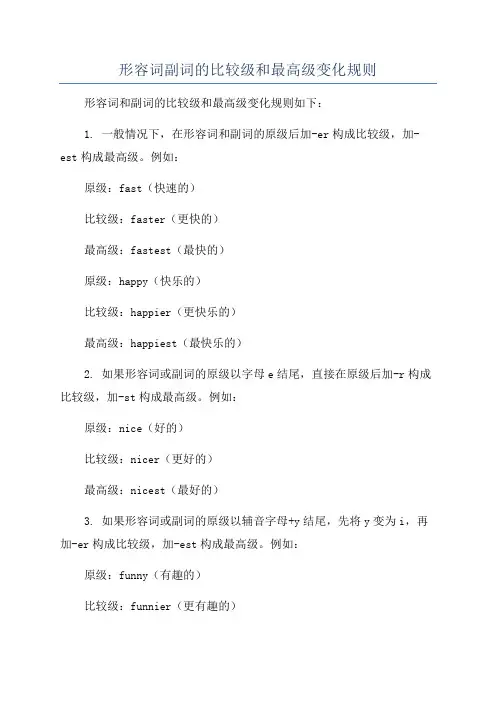
形容词副词的比较级和最高级变化规则形容词和副词的比较级和最高级变化规则如下:
1. 一般情况下,在形容词和副词的原级后加-er构成比较级,加-est构成最高级。
例如:
原级:fast(快速的)
比较级:faster(更快的)
最高级:fastest(最快的)
原级:happy(快乐的)
比较级:happier(更快乐的)
最高级:happiest(最快乐的)
2. 如果形容词或副词的原级以字母e结尾,直接在原级后加-r构成比较级,加-st构成最高级。
例如:
原级:nice(好的)
比较级:nicer(更好的)
最高级:nicest(最好的)
3. 如果形容词或副词的原级以辅音字母+y结尾,先将y变为i,再加-er构成比较级,加-est构成最高级。
例如:
原级:funny(有趣的)
比较级:funnier(更有趣的)
最高级:funniest(最有趣的)
4.一些形容词及副词的比较级和最高级形式不规则,需要进行记忆。
例如:
原级:good(好的)
比较级:better(更好的)
最高级:best(最好的)
原级:bad(坏的)
比较级:worse(更差的)
最高级:worst(最差的)
原级:far(远的)
比较级:farther(更远的)
最高级:farthest(最远的)
总的来说,形容词和副词的比较级和最高级的变化规则大致为在原级后添加-er和-est,但也有一些特殊情况需要记住。
形容词和副词的比较级和最高级1.1 形容词和副词的比较级和最高级大家好,今天我们来聊聊形容词和副词的比较级和最高级。
你们知道吗,形容词和副词的比较级和最高级可以帮助我们更好地描述事物的大小、程度和高低等。
比如说,我们可以用“更漂亮”来形容一个女孩比另一个女孩更漂亮,用“最高”来形容一座山比另一座山更高。
1.2 形容词和副词的比较级我们来说说形容词的比较级。
形容词的比较级通常在词尾加上“-er”,比如“big”变成“bigger”,“happy”变成“happier”。
也有一些不规则的形容词,比如“good”变成“better”,“bad”变成“worse”。
所以,当我们想要形容一个事物比另一个事物更大、更好时,就可以用形容词的比较级哦!1.3 形容词和副词的最高级接下来,我们来说说形容词的最高级。
形容词的最高级通常在词尾加上“-est”,比如“big”变成“biggest”,“happy”变成“happiest”。
但是,也有一些不规则的形容词,它们的比较级已经是最高级了,比如“good”变成“best”,“bad”变成“worst”。
所以,当我们想要形容一个事物是所有事物中最大、最好的时,就可以用形容词的最高级哦!2.1 副词的比较级和最高级除了形容词,副词也可以用来表示程度和高低。
副词的比较级和最高级同样是在词尾加上“-er”或“-est”。
比如,我们可以用“faster”来形容一个人跑得比另一个人快,用“highest”来形容一座山比另一座山更高。
不过,需要注意的是,有些副词的比较级和最高级是不规则的,比如“well”变成“better”,“badly”变成“worse”。
所以,当我们想要形容一个人做事情比另一个人更好、更差时,就可以用副词的比较级和最高级哦!2.2 副词的最高级副词的最高级同样是在词尾加上“-est”。
比如,我们可以用“fastest”来形容一个人跑得最快,用“highest”来形容一座山最高。
形容词、副词的比较级和最高级一.形容词和副词的比较级和最高级的变化方法如下(1) 符合规则的:( 1)和冠词连用the +形容词原级+v(复),指一类人或物the +形容词比较级,指两者中“较…的”的那一个,eg. the younger of thea/ an +形容词比较级eg. The pen is expensive. I want a cheaper one.( a) +most+形容词最高级“非常…”eg. a most beautiful city( 2 ) 相关结构a. 原级比较:肯定句as….as…., 否定句not so / as….as…..b.比较句:比较级+than….或more (less) ….than…..The furniture in this shop is less beautiful than that in that shop.c.比较级+and+比较级或more and more+比较级“越来越… ”richer and richer, more and more interestingd. The more….., the more…..“越…,越…”The more you look at the picture, the better you will like it.e. 比较级+than any other +n. (单)(适用于范围一致时)(all) other +n.(复)any +n.(单) (适用于范围不一致时)He is taller than any other student / all other students in his class.any student in my class.f. 倍数表达法。
A is three(four, etc.)times the size(height, length etc.)of B.A is three(four, etc.)times as big(high, long, etc.)as B.A is three (four, etc.)times bigger(higher, longer, etc.)than B.用times 表倍数通常用于三倍以上,两倍可以用twice或double.The new building is four times the size (the height)of the old one.Asia is four times as large as Europe.Your school is three times bigger than ours.g. 最高级+of/ in/ among….He is the tallest of the three/ among them/ in is class.形容词、副词的比较级和最高级专项练习(一)写出下列形容词与副词的比较级与最高级形式:long __ wide __ ___ fat _ ___ heavy _____ ____ slow _____ ____ few _____ ____ brightly ___ _____ important ___ _____ far ____ ______ quickly ____ ____ happy ___ ____ many ___ ____ interesting __ __good ___ ___(二)用所给词的正确形式填空:1. He ran ______ than all the others. He ran _______ of all. ( fast )2. James played as ______ as you. Mary played _______of all. ( well )3. She waited ________ than she usually did. ( long )4. I walked _______ than the rest. I walked _______ of all. ( far )5. My friend came ________ than Pual and Mike. ( late )6. Among the three boys he works ________. ( hard )7. Bob left school ______ in his class yesterday. ( late )8. He swims as ______ as I do. ( badly )9. Who did _______ in the 100-metre race, Jim or Tim? ( badly )10. Both Li Ming and Li Hong sang __________, but I sang _______ of all. ( badly )11. Peter is as _______ as Tom. Benny is _____ than Tom. David is ______ of all. ( fat )12. Li Li found _________ mushrooms than I did. ( many )13. The elephant is ________ than any other animals. ( big )14. Man is ________ than animals. ( much clever )15. Lesson Two is a bit ________ than Lesson One. ( easy )16. I’m _______ boy under the sun. ( happy )17. Today is ________ than yesterday. ( hot )18. An elephant is _______ than a tiger. It is _______ animal on land. ( big )19. Mr. Li is _______ than your uncle. ( thin )20. Which book is _________, yours or mine? ( thick )21. This park is much _______ than that one. ( beautiful )22. The first book is more useful than the second one.The second book is ______ than the first one. ( useful )23. Allan is _______ of the three boys. ( strong )24. His marks are _______ than his friend’s ( bad )25. It is _______ to do this maths problem than to do that one. ( easy )26. My house is ________ to the farm than yours. ( far )27. My work is more important than yours. Your work is ________ than mine. ( important )28. Climbing this hill is _________. Climbing that hill is ________. Climbing Mt. Everest is _______ of all. ( dangerous )29. Mt. Everest is _________ than the Mont-Blanc. ( high )30. My mother drives very carefully. She is a _________ driver than my father. ( careful ).31. Of the two girls, I find Lucy the _______ (clever).32. Gold(黄金) is ______ (little) useful than iron(铁).33. My sister is two years _______ (old ) than I.34. John’s parents have four da ughters, and she is the _____ (young) child.35. The _____ (cheap) bags are the not usually the best ones.36. The short one is by far _______ expensive of the five.37. The boy is not so ______ (interesting) as his brother.38. Dick sings _____ (well), she sings ______(well) than John, but Mary sings______(well) in her class.39. She will be much ______ (happy) in her mew house.40. This dress is ______ that.(twice, as…as…, expensive)(三)选择填空:1. He feels _____ today than yesterday. A. tired B. more tired C. more tireder D. much tired2. Which do you like _____, coffee, tea or milk? A. the worst B. worse C. the worse D. worst3. Of the two toys, the child chose_____.A. the expensive oneB. one most expensiveC. a least expensiveD. the most expensive of them4. The line is ____ than that one. A. more longer B. not longer C. much more longer D. many more longer5. The earth is _____ the moon.A. as 49 times big asB. 49 times as bigger asC. 49 times as big asD.as big as 49 times6. The book is ____ of the two. A. thinner B. the thinner C. more thinner D. the thinnest7. She looks _____ than she does. A. the more older B. very older C. much older D. more older8. The garden is becoming ______.A. more beautiful and moreB. more beautiful and beautifulC. more and more beautifulD. more beautiful and beautifuler9. They competed(比赛)to see who could work _____.A. the fastest and bestB. the faster and the betterC. fastest and betterD. faster and better10.______ hurry, _______speed. A. More, less B. Much, little C. The more, the less D. The much, the little11. This kind of coffee is different ______.A. and it is also betterB. and better than the otherC. but also than othersD. from the other, and better(四)翻译句子:1.本书跟那本书一样有趣。
一、形容词和副词的概念形容词:是修饰名词(人或事物),表示名词的性质,特征或属性一种词类.它在句中作定语、表语和宾语补足语。
副词:用来修饰动词、形容词及其他副词的词叫副词.副词在句中多作状语。
二、形容词和副词的用法①形容词作定语一般放在被修饰的名词之前。
如: a new book, two big trees等.②形容词放在系动词be , get, turn, become, keep, stay, look, smell, feel, taste,sound, 等之后.如:1。
I am short。
2。
She looks fine.3.They turn green.③如果形容词修饰不定代词something,anything, everything, nothing等时,要放在不定代词后面。
如:something interesting nothing new④副词放在所修饰的动词之后、形容词和副词之前.如果前面是行为动词,则后面用副词。
如: 1.She works hard .(修饰动词)2.I am very busy.(修饰形容词)3。
He runs too quickly .(修饰副词)4。
We play happily。
(修饰动词)⑤通常在形容词后加-ly变成副词。
形容词副词比较级最高级变化形式归纳大多数形容词和副词有比较级和最高级的变化,即原级、比较级和最高级,用来表示事物的等级差别。
原级即形容词的原形,比较级和最高级有规则变化和不规则变化两种。
规则变化1.单音节以及少数双音节的词后面直接加-er 或—est原级比较级最高级tall taller tallestsmart smarter smartestshort shorter shortest特别提醒:以-y,-er, -ow, le结尾的双音节形容词末尾加er和est.如:healthy, funny, busy, hungry, easy, happy, early, pretty, lazy, heavy,dirty, clever, narrow等。
可编辑修改精选全文完整版形容词、副词的比较级与最高级用法详解一、形容词、副词比较级、最高级构成大多数的形容词、副词都具有原级、比较级和最高级三种形式。
而形容词、副词的比较级、最高级构成方式分规则变化和不规则变化。
其规则变化的方式详见下面个表:(一)规则变化:(1) 直接在词尾加-er, -est(2) 以不发音字母e 结尾的,在词尾加-r , -st(3)以“辅音字母+y“结尾的,把y 变i,再加-er , -est(4) 以辅音字母结尾的重读闭音节词汇,双写最后一个辅音字母,再加-er , -est(5) 部分双音节和多音节词,在其前加more, most(二)、不规则变化:比较级、最高级具有不规则变化形式的形容词和副词比较少,因此,需要大家逐一认真记忆。
详见下表:【妙记顺口溜】“坏”“病”两“多”和两“好”,一是“远”来,二是“老”,little 是“少”不是“小”。
二、形容词、副词比较级和最高级用法(一)形容词、副词比较级用法形容词、副词的比较级主要对两个的人或物在某种程度、性质上进行比较。
常见的形容词副词比较级用法如下:1.同级比较① A+be/v+as+原级+as+B A和B一样This room is as large as that one .这间房子和那间一样大(形容词)Tom writes as carefully as Kate.汤姆写字跟凯特一样认真。
(副词)②A+be/V+not+as(so)+级+as +B A 不如BTigers aren't as(so) dangerous as lions.老虎不如狮子危险。
(形容词)Mary didn't finish the work as(so) well as Lucy.玛丽完成这项工作不如露西好。
(副词)2.差极比较①A+be/v+比较级+B A比B更......This pen is newer than that one.这支钢笔比那支新。
形容词和副词的比较级和最高级形式形容词和副词的比较级和最高级形式是英语语法中一项重要的知识点。
掌握了这些形式,我们就能够更准确地描述事物的特点、比较不同事物之间的差异,并且能够提升我们的表达能力。
本文将对形容词和副词的比较级和最高级形式进行详细介绍,并提供一些相关的例句。
一、形容词的比较级和最高级形式1. 比较级形式形容词的比较级形式用于比较两个事物之间的差异,表达一物在某方面较另一物更高、更远、更大、更好等。
比较级形式的构成方式有以下几种(取决于形容词的词尾变化):a) 一般情况下,直接在形容词后面加上“-er”,如:taller(更高的)、bigger(更大的)等。
例句:- She is taller than her sister.(她比她的姐姐高。
)- This book is more interesting than that one.(这本书比那本书更有趣。
)b) 以“辅音字母+y”结尾的形容词,要变“y”为“i”,再加上“-er”,如:happier(更快乐的)、funnier(更有趣的)等。
例句:- The weather today is sunnier than yesterday.(今天的天气比昨天更阳光明媚。
)- The movie we saw last night was scarier than we expected.(我们昨晚看的电影比我们预想的要吓人。
)c) 以重读闭音节结尾的形容词,要双写最后一个辅音字母,再加上“-er”,如:bigger(更大的)、darker(更暗的)等。
例句:- The baby's eyes are bigger than her hands.(婴儿的眼睛比她的手大。
)- The room becomes darker as the night falls.(晚上降临时,房间变得更黑暗。
)2. 最高级形式形容词的最高级形式用于在三个或三个以上事物之间进行比较,表达最高级的程度,即某物在某方面最高、最远、最大、最好等。
矿产资源开发利用方案编写内容要求及审查大纲
矿产资源开发利用方案编写内容要求及《矿产资源开发利用方案》审查大纲一、概述
㈠矿区位置、隶属关系和企业性质。
如为改扩建矿山, 应说明矿山现状、
特点及存在的主要问题。
㈡编制依据
(1简述项目前期工作进展情况及与有关方面对项目的意向性协议情况。
(2 列出开发利用方案编制所依据的主要基础性资料的名称。
如经储量管理部门认定的矿区地质勘探报告、选矿试验报告、加工利用试验报告、工程地质初评资料、矿区水文资料和供水资料等。
对改、扩建矿山应有生产实际资料, 如矿山总平面现状图、矿床开拓系统图、采场现状图和主要采选设备清单等。
二、矿产品需求现状和预测
㈠该矿产在国内需求情况和市场供应情况
1、矿产品现状及加工利用趋向。
2、国内近、远期的需求量及主要销向预测。
㈡产品价格分析
1、国内矿产品价格现状。
2、矿产品价格稳定性及变化趋势。
三、矿产资源概况
㈠矿区总体概况
1、矿区总体规划情况。
2、矿区矿产资源概况。
3、该设计与矿区总体开发的关系。
㈡该设计项目的资源概况
1、矿床地质及构造特征。
2、矿床开采技术条件及水文地质条件。